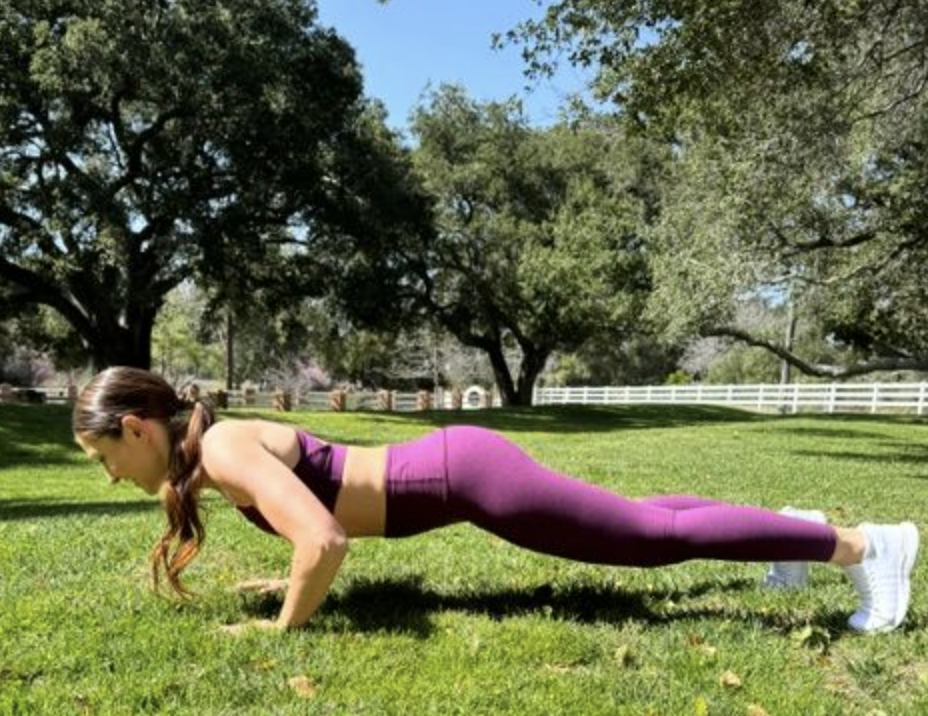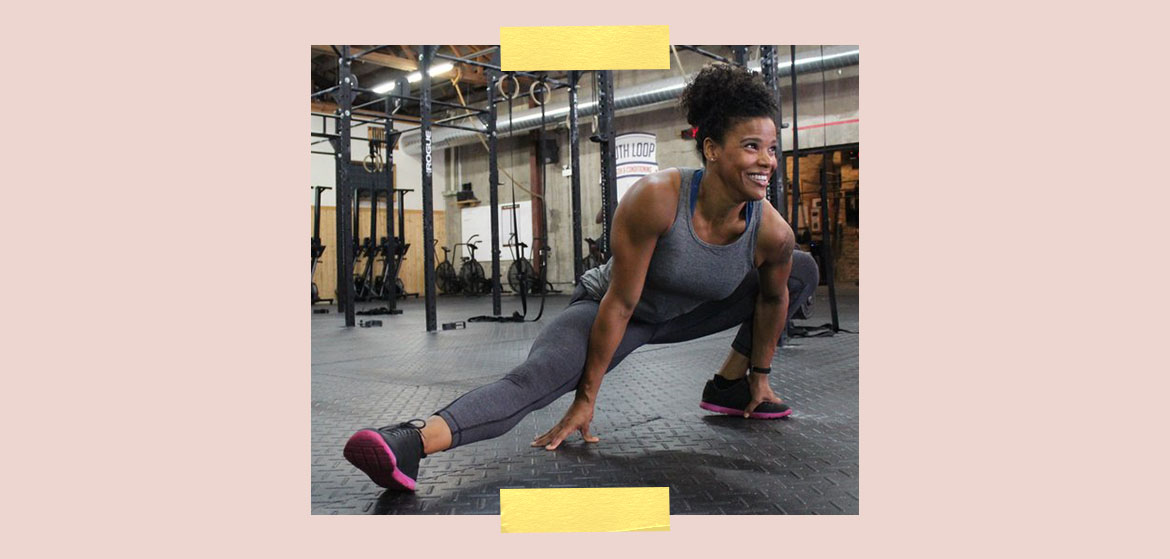Push-ups are one of the most basic exercises out there. But they’re by no means easy. So many people who are otherwise fit find excuses to skip them—which means they’re missing out on all the major benefits of push-ups.
“Push-ups are probably the only exercise that everyone I work with works on,” says personal trainer Kristie Larson, CSCS.
And for good reason: Although we think of push-ups as a go-to upper-body exercise, this move actually has surprising perks for your entire body. So even if you struggle to do a set on your knees or against the kitchen counter, there are good reasons to keep trying.
How to do a push-up with perfect form
To get the most out of a push-up, you have to do the move correctly. Here’s how to do a push-up with correct form:
Photo: Jenna Willis
Begin on your hands and knees in a tabletop position, hands under your shoulders and knees under your hips.
Step your feet back and straighten your legs into a high plank position. Your body should make a straight line from head to hips to heels, and your hands should be directly under your shoulders or slightly wider apart.
Bend your elbows at a 45-degree angle to your body and lower your body to the floor.
Press into your palms and push the floor away from you to come back up to a high plank.
Repeat.
8 benefits of push-ups that’ll get your arms (and heart) pumping
Although the main reason people do push-ups is to work on their upper-body strength, there’s a lot more this gym-class exercise can offer.
1. They can improve your posture
A lot of the variables that come into play to support your posture can be strengthened by doing push-ups.
“We’re practicing how the shoulder blades move,” Larson says. “We’re aligning our torso in such a way that we’re stacking our rib cage over our pelvis in a horizontal plane, which helps reinforce that positioning in any type of vertical movement.”
When you stand up after a set of push-ups, more likely than not, you’ll be standing tall.
2. They could protect your heart health
A February 2019 study in JAMA Network Open found that men who were able to do 40 push-ups were 96 percent less likely to have experienced cardiovascular problems 10 years later than those who could complete fewer than 10 push-ups. That’s a major difference.
Of course, only men were tested so we don’t know if the same would hold true in women, and those who could pull off 40 push-ups were likely doing other things to stay healthy, too. But the exercise proved to be an incredibly reliable marker of heart health.
3. They build whole-body coordination
You can’t perform a push-up just by relying on one part of your body.
“In order to be able to move up and down in one piece, you have to have your whole body engaged and also be able to focus on keeping your core tight while you’re really working the shoulders, triceps, and chest,” says strength coach Elisabeth Akinwale, CPT.
4. They’re a core workout in disguise
Most of us are spending so much energy thinking about our upper bodies during push-ups that we forget they’re simply a moving plank.
“It’s an entire core workout, which people don’t realize,” says ISSA-certified celebrity fitness trainer Jenna Willis. “And I’m talking about your abs, back, and glutes.”
5. They work your pelvic floor
You don’t need to actively think about doing a Kegel during a push-up; the movement will engage your pelvic floor no matter what.
That’s because the pelvic floor is part of our core, and we need it to stabilize your body to hold a plank, according to Willis. (Just be sure to speak with a pelvic floor therapist first if you’re struggling with prolapse, because push-ups could exacerbate the problem.)
6. It helps you with everyday life
One of the biggest benefits of push-ups is that they can help prepare you for all kinds of movements in daily life, like putting luggage into an overhead carrier or pushing your kids on the swing.
“A lot of people forget that push-ups are a functional movement,” Willis says. “It’s a movement that we use every single day.”
7. They’re super accessible
Not only can you do push-ups anywhere, any time, without equipment. Larson points out most people can find a version of push-up that works for their body.
“There are so many variations of push-ups and they’re all real push-ups,” she says. “They’re very scalable,” she says.
If a horizontal push-up on the floor is too challenging, you can push off of a wall at a slight incline. Or, if you’re an elite athlete, you can do explosive plyometric push-ups jumping off of the floor.
8. Push-ups makes you feel badass
Larson says successfully conquering push-ups is a common goal among her clients—especially women who’ve been told all their lives that doing push-ups from your knees is the “girl version.”
While she emphasizes that all versions of push-ups are legitimate, Larson says it can be especially fulfilling to do them from two feet. “You kind of look like a certified badass when you’re able to bust out some push-ups,” Willis says.
The muscles worked during push-ups
Doing a push-up will engage nearly all the muscles in the front of your body. Here’s exactly which muscles you work when doing this exercise:
Primary muscles: The pectoral muscles (or pecs) in your chest, the triceps on the backs of your arms, and the anterior deltoid in your shoulders are the main muscles being used in a push-up.
Secondary muscles: Other muscles that push-ups work include your core, shoulder stabilizers, and—if you’re pushing up from a straight-leg position—quadriceps.
“There are so many variations of push-ups and they’re all real push-ups. They’re very scalable.” —Kristie Larson, CSCS
Push-up variations for beginners
If you want to work on your push-ups, but aren’t there just yet, Larson suggests practicing your plank position. “I won’t even start someone moving until they can hold a plank with straight arms for 15 seconds,” she says.
Once you’re ready to start lowering, head over to a wall, and do a push-up off of there. The incline will lighten how much weight you’re moving up and down. As you get comfortable, get lower. “Go from a wall to pushing off of a bench, and maybe from a bench to a lower box. And then maybe to the floor,” Larson says.
You can also try starting from lying down on the ground, and just pushing up from there. “That bottom range is where it gets dicey,” Larson points out. This way, you can begin at the point where you’d typically collapse, and get a sense of how it’s supposed to feel. You can also get a little bit of momentum by picking your hands up an inch off the floor, then forcefully pushing them down right before your push-up. “You’re able to actually explore that most challenging range without actually needing to have the strength to come down into it and up out of it,” Larson says.
Willis suggests looping a resistance band around your elbows. As you do a push-up, “you’ll literally fall into the resistance band,” she says. Or, adds Akinwale, you can loop a resistance band around your hips and connect it to something like a pull-up bar behind you to take some of your weight.
There’s also, of course, the classic modification of doing push-ups with your knees on the ground, rather than your feet. Akinwale suggests still finishing knee push-ups in plank position, however, to get that full-body engagement.
Push-up tips to keep in mind
Many people who struggle with push-ups don’t necessarily lack the strength to do them; they just haven’t figured out the proper coordination. Often, Larson says once clients pull off one push-up, they can suddenly do five—even when that seemed impossible a day earlier.
“When it clicks into place, it’s actually so often not about pure strength. It’s really about the mechanics combined with strength,” she says.
If you want to reap all those great benefits of push-ups, keep these tips in mind to nail the proper technique.
1. Spread your fingers wide, and think of gripping them on the floor “almost like how frogs have those little pads on their fingertips,” Akinwale says.
2. Keep your elbows at a 45-degree angle to your torso. When they go straight out to the sides, it’s a more difficult position for your shoulders, and can be painful, according to Akinwale.
3. Stack your shoulders on top of your hands. It’s tempting to let the hands reach higher up, but that won’t engage your pecs properly, Larson says.
4. Think ahead. “As you get to the bottom, you want to anticipate that turnaround before you go all the way down—otherwise, you might lose some tension,” Akinwale says.
5. Don’t peel off the floor like a banana. “Keep that nice, strong core and lift off the floor in one straight motion versus that peeling motion,” Willis says.
6. Watch yourself. Akinwale suggests filming yourself or using a mirror to check that your positioning hits all the above boxes. “Otherwise, you’re building on a poor foundation,” she says.
7. Be consistent. When you’re working to conquer that first push-up, you need to do them often enough for your body to adapt to the challenge. All of the trainers we spoke to recommend doing them about every other day or three times a week to build up the necessary strength.
FAQ
1. How many push-ups should you do a day?
The number of push-ups you shoot for depends on your personal goals and what you’re working on. But Akinwale says a good goal is 7 to 10 high-quality push-ups. The key, Willis reiterates, is “high-quality.” Stop as soon as your form starts to deteriorate, otherwise you could injure yourself.
2. What happens if I do push-ups every day?
There’s nothing wrong with doing push-ups daily, but you might start to get sore. “If you can do them every day and it feels fine for you, great,” Larson says. “I don’t think there’s really any inherent risk there.”






